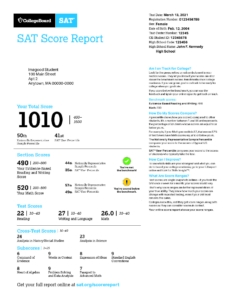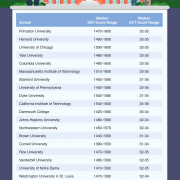When someone asks what you got on the SAT, you probably know what your total score is. You probably know your score for each of the two sections. But what about all the other numbers on the SAT score report? Let’s go through an SAT score report to look at what your SAT scores mean.
 Total Score
Total Score
The total score ranges from 400 to 1600 points. It is the total of the section scores for Math and Evidence-Based Reading and Writing.
How much your total score counts will depend on the SAT score use policies at your chosen colleges. Some colleges look at the total score for a single test date; in this case, your total score is very important. Other colleges practice what’s known as “super scoring” – they combine section scores from across test dates to calculate your highest possible total score. If you’re applying to schools that look at the highest section (which means that they super score), then your section scores will matter more to you than your total score.
Underneath the total score are two percentile rankings. The Nationally Representative Same Percentile is based on a research study of students in 11th and 12th grade. It is weighted to represent all U.S. students in those grades, regardless of whether or not they would be likely to take the SAT. The SAT User Percentile is a bit more informative. It is based on the actual scores of students in the prior year’s graduating class. This percentile tells you how well you performed compared to other SAT test-takers.
If we look at this sample score report, we see that this student is in the 41st percentile among SAT users. This means that she scored better than 41% of SAT test-takers in the prior year’s graduating class.
Section Scores
There are two section scores: one for Math and one for Evidence-Based Reading and Writing. These scores are particularly important when you’re considering applying to colleges that super score. Schools that have a “highest section” SAT score use policy will combine your highest section scores from across test dates. In this case, your section scores may well be more important to you than your total score.
The score report includes percentiles for each section as well. These percentiles are based on the same cohorts as the percentiles for the total score.
Test Scores
Test scores are reported from 10 to 40 for each of the three main subjects on the SAT: Reading, Writing, and Math.
You earn a raw score for each section of the test: one point for each correct answer and zero points for each blank or incorrect answer. The raw score is then converted to these scaled test scores. The conversion differs from test to test.
The test scores for Reading and for Writing are added together and multiplied by ten to get the Evidence-Based Reading and Writing section score. The Math test score is multiplied by twenty to get the Math section score.
Cross-Test Scores
Cross-Test Scores are reported from 10 to 40. They show how well you performed on science and social studies questions that are embedded across all sections of the SAT. These scores really don’t reveal much about your academic performance, and colleges don’t generally look very closely at them
Subscores
These scores range from 1 to 15. They show how well you performed on specific types of questions. Colleges don’t look very closely at these scores, but these scores can be helpful if you plan on preparing to take the test again because they can help you identify strengths and weakness to better target your test prep.
Get Extra Help
Not quite happy with your SAT score yet? Taking advantage of an SAT prep programs like those created by C2 Education can help you maximize your SAT score.








